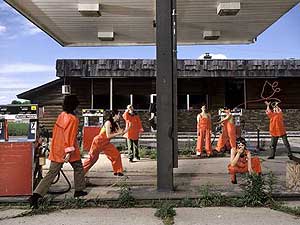|
Audio
Photos
Resources
Your Voice
|
Feel the heat
October 25, 2004
 |
| Catalyst, performing "Heat and Life" at a gas station. Emily Johnson's new dance production is about habitat change due to global warming. (Photo by Cameron Wittig, courtesy of the Walker Art Center) |
Minneapolis, Minn. — For the last two years, Emily Johnson has been reading about global climate change. What she's learned terrifies her. For many, global warming is a remote issue, more fodder for a Hollywood disaster movie than an imminent threat. Johnson doesn't understand why more people don't share her fear.
 | |||
"I don't think a lot of people know that it is happening now," she says. "Populations of humans and other species are being moved from places that they've been for years, whether that's been decades or hundreds of thousands of years. They're being moved from that space because their land is gone, or being diminished."
Johnson's new dance production is about habitat change due to global warming, and the human response to it. She calls it "Heat and Life." Her goal is to give the audience a sense of what global warming might be like.
A good portion of "Heat and Life" took shape in Johnson's native Alaska, where she brought her entire company this past year. They performed work-in-progress excerpts on a treacherous glacier and an ocean beach. Johnson is also one sixteenth Yup'ik Eskimo. She says it made sense to build a piece so close to her heart in the place where she grew up.
"And also for me seeing oil barges coming in and going out constantly in Valdez," she says. "That has had a big influence and just where the money comes from in Alaska, which is from oil, and I wanted to do some part of this piece and I wanted to be there rehearsing this piece because of that."
Johnson's dance company, Catalyst, will perform "Heat and Life" in the Soap Factory in Minneapolis. It's a warehouse that's been converted into a visual art and performance space. Johnson says the building has a foreboding, post-industrial ambience that suits the piece.
 | |||
The space is cordoned into little sections by orange ropes. The dancers wear blaze orange protective rain gear, goggles and breathing masks. They look like emergency workers at a superfund site.
The performers dart, crawl, or march across the stage, sometimes in unison, but often oblivious of one another. The movement is quirky and minimal, spastic then beautifully smooth, communicating anxiety, fear, even paranoia.
At one point, one performer barks out orders to her fellow dancers on a walkie talkie, even though most of them are within a few steps of her.
"I wanted to create an image like even though the dancers are literally ten feet apart that they maybe are talking to each other as if they're two miles apart," she says, "so that they have that very impersonal reaction to each other."
For Johnson, the image is a metaphor for society's response to climate change.
"If we continue to not pay attention to how we treat our environment and how we treat the places that we live, our quality of life will be reduced and I think that I do paint a bit of a picture on stage that no one would want to live in," she says.
 | |||
Minneapolis ambient jazz musician J.G. Everest, is Johnson's longtime collaborator. He composed the soundscape for "Heat and Life." Everest will play live during performances at the Soap Factory this Thursday through Saturday. He's created an eerie amalgamation of electronic and instrumental music, and sounds gathered in Alaska and at the Soap Factory.
"I've just been pulling all those elements of actual environmental found sounds, and using a computer I got specifically for this in order to be able to really cut up and take those sounds and mold them into something really musical," Everest says.
Some might be tempted to take a cynical view of "Heat and Life," as emanating from yet another artist with an issue and a platform on which to preach. But Johnson says that's not her intention.
"I'm not going to teach anybody about climate change in this piece," she says. "I'm not gonna present any facts about it. I really have an emotional response to climate change and that's what this piece is."
What's important to Johnson is whether an abstract dance piece can affect how people view global warming. She's constantly asking herself whether art can create change.
 | |||
"In this piece I've been working on for a year and a half, and there's this amount of money that I've spent, paying dancers, bringing them to Alaska, paying for these costumes and this equipment and the sound and the video," she says. "And then I think about, well, would all these thousands of dollars be better spent directly put into an organization that does something very specific about climate change. And maybe that's true......"
Organizations do their work, Johnson says. She says what artists can do is speak directly to the heart and gut, transporting an audience from a factual world into a personal one.
|
News Headlines
|
Related Subjects
|
